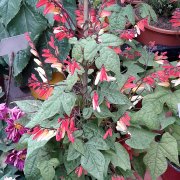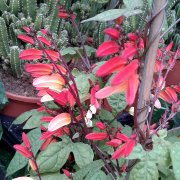Care of the climbing plant Ipomoea lobata or Spanish flag |
|
The genus Ipomoea, family Convolvulaceae, comprises 300 species of climbing plants native to America and Africa. Some species are: Ipomoea lobata, Ipomoea indica, Ipomoea cairica, Ipomaea alba, Ipomoea tricolor, Ipomoea purpurea, Ipomoea acuminata, Ipomoea hederacea, Ipomoea coccinea. Common names: Firecracker vine, Fire vine, Spanish flag. This species is native to Mexico and parts of South America. They are fast-growing herbaceous climbing plants that reach 5 meters (16.4 feet) in length. They have deciduous 3-lobed leaves and reddish petioles. The abundant and showy tubular flowers appear in clusters and are red in color; they then turn orange and yellow until they turn whitish before wilting. They bloom throughout the summer and early fall. Spanish flag is used as annual indoor plants in temperate climates and to cover pergolas, walls, and gates in tropical and subtropical climates. Ipomoea lobata needs a very illuminated exposure without receiving direct sun in the hottest hours of the day. It does not resist the cold below 10 ºC (50 ºF). Fire vine prefers a light, well-drained soil with abundant organic matter; use a substrate for indoor plants with 20% coarse sand. It does not resist transplantation well. Water frequently so that the soil is always humid but without flooding; they do not withstand drought. Fertilize in late winter with compost. Prune withered inflorescences to favor the appearance of more flowers. If the humidity is low or Ipomoea lobata suffers from drought, it can be attacked by aphids, mites and mealybugs. If it receives too much sun the leaves turn yellow. Firecracker vine propagates from seeds sown in spring directly in their final location. |
Images of the climbing plant Ipomoea lobata or Spanish flag |
Find plants
Ipomoea lobata or Spanish flag | Care and Growing
© 2024 FavThemes


